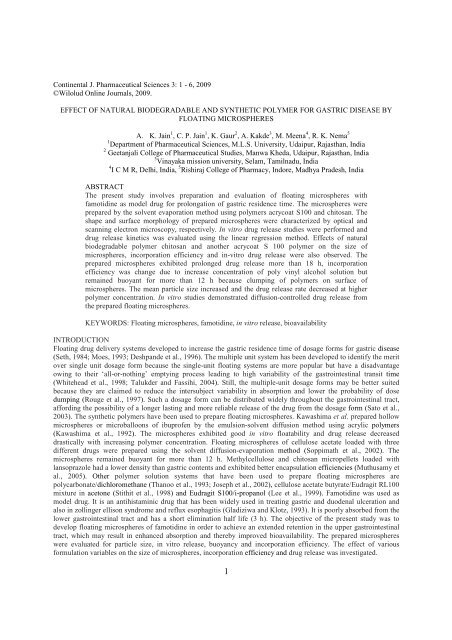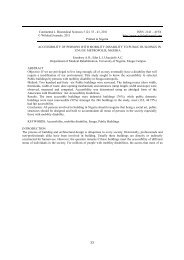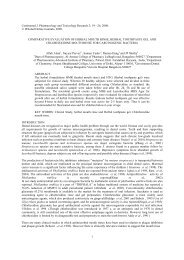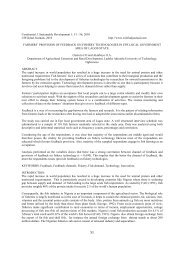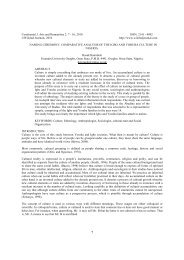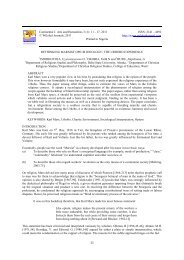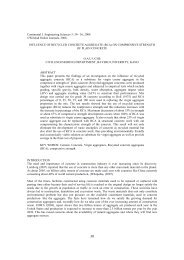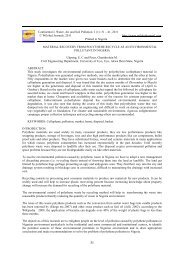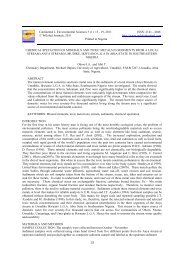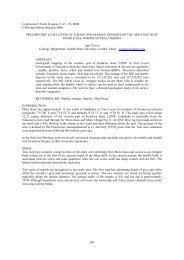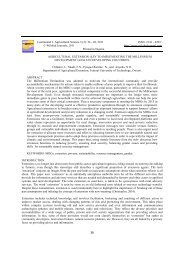Vol 3 - Cont J Pharm Sci - Wilolud Journals
Vol 3 - Cont J Pharm Sci - Wilolud Journals
Vol 3 - Cont J Pharm Sci - Wilolud Journals
You also want an ePaper? Increase the reach of your titles
YUMPU automatically turns print PDFs into web optimized ePapers that Google loves.
<strong>Cont</strong>inental J. <strong>Pharm</strong>aceutical <strong>Sci</strong>ences 3: 1 - 6, 2009<br />
©<strong>Wilolud</strong> Online <strong>Journals</strong>, 2009.<br />
EFFECT OF NATURAL BIODEGRADABLE AND SYNTHETIC POLYMER FOR GASTRIC DISEASE BY<br />
FLOATING MICROSPHERES<br />
A. K. Jain 1 , C. P. Jain 1 , K. Gaur 2 , A. Kakde 3 , M. Meena 4 , R. K. Nema 5<br />
1 Department of <strong>Pharm</strong>aceutical <strong>Sci</strong>ences, M.L.S. University, Udaipur, Rajasthan, India<br />
2 Geetanjali College of <strong>Pharm</strong>aceutical Studies, Manwa Kheda, Udaipur, Rajasthan, India<br />
3 Vinayaka mission university, Selam, Tamilnadu, India<br />
4 I C M R, Delhi, India, 5 Rishiraj College of <strong>Pharm</strong>acy, Indore, Madhya Pradesh, India<br />
ABSTRACT<br />
The present study involves preparation and evaluation of floating microspheres with<br />
famotidine as model drug for prolongation of gastric residence time. The microspheres were<br />
prepared by the solvent evaporation method using polymers acrycoat S100 and chitosan. The<br />
shape and surface morphology of prepared microspheres were characterized by optical and<br />
scanning electron microscopy, respectively. In vitro drug release studies were performed and<br />
drug release kinetics was evaluated using the linear regression method. Effects of natural<br />
biodegradable polymer chitosan and another acrycoat S 100 polymer on the size of<br />
microspheres, incorporation efficiency and in-vitro drug release were also observed. The<br />
prepared microspheres exhibited prolonged drug release more than 18 h, incorporation<br />
efficiency was change due to increase concentration of poly vinyl alcohol solution but<br />
remained buoyant for more than 12 h because clumping of polymers on surface of<br />
microspheres. The mean particle size increased and the drug release rate decreased at higher<br />
polymer concentration. In vitro studies demonstrated diffusion-controlled drug release from<br />
the prepared floating microspheres.<br />
KEYWORDS: Floating microspheres, famotidine, in vitro release, bioavailability<br />
INTRODUCTION<br />
Floating drug delivery systems developed to increase the gastric residence time of dosage forms for gastric disease<br />
(Seth, 1984; Moes, 1993; Deshpande et al., 1996). The multiple unit system has been developed to identify the merit<br />
over single unit dosage form because the single-unit floating systems are more popular but have a disadvantage<br />
owing to their ‘all-or-nothing’ emptying process leading to high variability of the gastrointestinal transit time<br />
(Whitehead et al., 1998; Talukder and Fassihi, 2004). Still, the multiple-unit dosage forms may be better suited<br />
because they are claimed to reduce the intersubject variability in absorption and lower the probability of dose<br />
dumping (Rouge et al., 1997). Such a dosage form can be distributed widely throughout the gastrointestinal tract,<br />
affording the possibility of a longer lasting and more reliable release of the drug from the dosage form (Sato et al.,<br />
2003). The synthetic polymers have been used to prepare floating microspheres. Kawashima et al. prepared hollow<br />
microspheres or microballoons of ibuprofen by the emulsion-solvent diffusion method using acrylic polymers<br />
(Kawashima et al., 1992). The microspheres exhibited good in vitro floatability and drug release decreased<br />
drastically with increasing polymer concentration. Floating microspheres of cellulose acetate loaded with three<br />
different drugs were prepared using the solvent diffusion-evaporation method (Soppimath et al., 2002). The<br />
microspheres remained buoyant for more than 12 h. Methylcellulose and chitosan micropellets loaded with<br />
lansoprazole had a lower density than gastric contents and exhibited better encapsulation efficiencies (Muthusamy et<br />
al., 2005). Other polymer solution systems that have been used to prepare floating microspheres are<br />
polycarbonate/dichloromethane (Thanoo et al., 1993; Joseph et al., 2002), cellulose acetate butyrate/Eudragit RL100<br />
mixture in acetone (Stithit et al., 1998) and Eudragit S100/i-propanol (Lee et al., 1999). Famotidine was used as<br />
model drug. It is an antihistaminic drug that has been widely used in treating gastric and duodenal ulceration and<br />
also in zollinger ellison syndrome and reflux esophagitis (Gladiziwa and Klotz, 1993). It is poorly absorbed from the<br />
lower gastrointestinal tract and has a short elimination half life (3 h). The objective of the present study was to<br />
develop floating microspheres of famotidine in order to achieve an extended retention in the upper gastrointestinal<br />
tract, which may result in enhanced absorption and thereby improved bioavailability. The prepared microspheres<br />
were evaluated for particle size, in vitro release, buoyancy and incorporation efficiency. The effect of various<br />
formulation variables on the size of microspheres, incorporation efficiency and drug release was investigated.<br />
1
A. K. Jain et al: <strong>Cont</strong>inental J. <strong>Pharm</strong>aceutical <strong>Sci</strong>ences 3: 1 - 6, 2009<br />
EXPERIMENTAL<br />
Materials and Apparatus<br />
Famotidine was obtained as a gift sample from Intas <strong>Pharm</strong>aceutical, Ahmedabad. Polyvinyl alcohol was obtained<br />
from S.D. Fine Chemicals Ltd. Mumbai. Dichloromethane, ethyl acetate, acetone, acrycoat S100, chitosan were<br />
obtained from Central Drug House (Pvt) Ltd. Delhi. All other chemicals/reagents were used of analytical grade.<br />
Table 1: Different formulations of floating microspheres<br />
S. No. Code<br />
Drug:<br />
ratio<br />
Polymer<br />
Organic solvent system<br />
Polyvinyl<br />
alcohol<br />
(%w/v)<br />
1. C1* 1:1 Dichloromethane: Ethanol 1:1 0.25<br />
2. C2 1:2 Dichloromethane: Ethanol 1:1 0.25<br />
3. C3 1:3 Dichloromethane: Ethanol 1:1 0.25<br />
3. C4* 1:1 Dichloromethane: Ethanol 1.:1 0.5<br />
3. C5* 1:1 Dichloromethane: Ethanol 1:1 1.0<br />
4. A1 1:1 Dichloromethane: Ethanol 1:1 2.0<br />
5. A2 1:2 Dichloromethane: Ethanol 1:1 2.0<br />
6. A3 1:3 Dichloromethane: Ethanol 1:1 2.0<br />
*Formulation coded with different concentration of polyvinyl alcohol (% w/v) using same drug:<br />
polymer ratio<br />
Code<br />
Buoyancy<br />
Table 2: Various formulation parameters for microspheres<br />
Mean Incorporation<br />
Husner’s<br />
size a (%) b<br />
particle efficiency percentage b ratio<br />
Carr’s index Angle of<br />
repose (θ)<br />
C1*<br />
375.1±1.818 86.15±0.044 80.6±2.1 1.66±0.023 14.285±0.345 23.41 ° ±0.035<br />
C2<br />
378.7±2.914 83.15±0.011 79.01±3.3 1.146±0.059 12.79±0.421 22.43 ° ±0.581<br />
C3<br />
389.3±1.984 84.15±0.012 77.56±3.6 1.166±0.039 12.35±0.746 22.15 ° ±0.351<br />
C4*<br />
376.1±1.657 85.52±0.065 81.7±2.1 1.56±0.056 13.13±0.345 22.24 ° ±0.028<br />
C5*<br />
379.1±1.546 84.38±0.038 82.8±2.1 1.42±0.073 13.06±0.254 21.85 ° ±0.026<br />
A1<br />
380.8±2.164 83.15±0.032 76.14±2.1 1.58±0.046 13.58±0.546 22.87 ° ±0.124<br />
A2<br />
383.6±1.854 83.51±0.034 74.85±1.8 1.42±0.028 12.468±0.214 21.85 ° ±0.256<br />
A3<br />
390.6±1.931 81.35±0.016 75.56±1.9 1.35±0.075 11.845±0.587 20.85 ° ±0.428<br />
a Mean±SD, n=10. b Mean±SD, n=3.<br />
Preparation of microspheres<br />
Microspheres were prepared by the solvent evaporation emulsification technique as employed by Struebel et al.<br />
(Struebel et al., 2003). Famotidine as model drug and polymers such as acrycoat S100 (batch A1-A3) or chitosan<br />
(batch C1-C5) was dissolved in a mixture of solvent system at room temperature to be prepare different formulation<br />
systems (Table 1). This dispersed medium was poured into 150 mL 0.1 M acidic solution containing polyvinyl<br />
alcohol as continuous medium at room temperature and subsequently stirred at ranging agitation speed for 2 h to<br />
2
A. K. Jain et al: <strong>Cont</strong>inental J. <strong>Pharm</strong>aceutical <strong>Sci</strong>ences 3: 1 - 6, 2009<br />
allow the volatile solvent evaporate. The prepared microspheres were filtered, washed with distilled water and dried<br />
in vacuum.<br />
Characterization of microspheres<br />
Size and shape of microspheres: The size of microspheres was determined using a microscope (Olympus NWF 10x,<br />
Educational <strong>Sci</strong>entific Stores, India) fitted with an ocular micrometer and stage micrometer. Scanning electron<br />
microscopy (SEM) (Philips-XL-20, The Netherlands) was performed to characterize the surface of formed<br />
microspheres. Microspheres were mounted directly onto the sample stub and coated with gold film (~ 200 nm)<br />
under reduced pressure (0.133 Pa).<br />
Flow properties: It was determined in terms of carr’s index (Ic) and hausner’s ratio (H R ) using following equations:<br />
H R =ρ t/ ρ b<br />
I c =ρ t- ρ b/ ρ t<br />
Figure 1: Scanning electron microscopy photographs of floating microspheres<br />
The angle of repose (θ) of the microspheres, which measure the resistance to particle flow, was determined by fixed<br />
funnel method by using following equation:<br />
tan θ=2H/D<br />
Where, 2H/D is the surface area of the free standing height of the microspheres heap that formed after making the<br />
microspheres flow from the glass funnel.<br />
Buoyancy percentage: Microspheres (0.3 g) were spread over the surface of a USP XXIV dissolution apparatus<br />
(type II) filled with 150 ml 0.1 mol L –1 hydrochloric acid (USP, 2000). The medium was agitated with a paddle<br />
rotating at 500 rpm for 12 h. The floating and the settled portions of microspheres were recovered separately. The<br />
floated microspheres were collect by decantation and weighed.<br />
Buoyancy % = Floated mass of prepared microspheres / Total mass of prepared microspheres<br />
Incorporation efficiency: To determine the incorporation efficiency, prepared microspheres were taken, thoroughly<br />
triturated in pestle mortar equivalent as drug used in formulation and suspended in a 5 ml of dichloromethane as<br />
dissolving medium. The suspension was suitably diluted with water and filtered to separate shell fragments. Drug<br />
content was analyzed spectrophotometrically at 265 nm.<br />
In-vitro drug release: A USP basket apparatus has been used to study in vitro drug release from microspheres (Singh<br />
and Kim, 2000; Dinarvand et al., 2002; Abrol et al., 2004). In the present study, drug release was studied using a<br />
modified USP XXIV dissolution apparatus type I (basket mesh # 120, equals 125 µm) at 100 rpm in distilled water<br />
and 0.1 mol L –1 hydrochloric acid (pH 1.2) as dissolution fluids (900 ml) maintained at 37 ± 0.5 °C. Withdrawn<br />
samples (10 ml) were analyzed spectrophotometrically as stated above. The volume was replenished with the same<br />
3
A. K. Jain et al: <strong>Cont</strong>inental J. <strong>Pharm</strong>aceutical <strong>Sci</strong>ences 3: 1 - 6, 2009<br />
amount of fresh dissolution fluid each time to maintain the sink condition. All experiments were performed in<br />
triplicate. Linear regression was used to analyze the in vitro release mechanism.<br />
Statistical analysis: Experimental results were expressed as mean ± SD. Student’s t-test and one-way analysis of<br />
variance (ANOVA) were applied to check significant differences in drug release from different formulations.<br />
Differences were considered to be statistically significant at P< 0.05.<br />
RESULTS AND DISCUSSION<br />
Floating microspheres were prepared by the solvent evaporation method by using acrycoat S100 and chitosan (Table<br />
1). The SEM photographs showed that the fabricated microspheres were spherical with a smooth surface and<br />
exhibited a range of sizes within each batch (Fig. 1). The microspheres floated for prolonged time over the surface<br />
of the dissolution medium without any apparent gelation. Buoyancy percentage of the microspheres was shown in<br />
Table 2.<br />
Figure 2: Effect of chitosan polymeric concentration on in vitro drug release from floating microspheres (bars<br />
represents mean±SD; n=3)<br />
Microspheres were prepared using different polymers with gradually increasing polymer concentration and same<br />
polymer with variability in concentration of PVA in combination with a fixed concentration of drug to assess the<br />
effect of polymer concentration on the size of microspheres. The mean particle size of the microspheres significantly<br />
increased with increasing cellulose acetate concentration (p < 0.05) and was in the range 375.1±1.818 to<br />
389.3±1.984 µm (Table II). The viscosity of the medium increases at a higher polymer concentration resulting in<br />
enhanced interfacial tension (Reddy et al., 1990; Ishizaka, 1981). The size of prepared microsphere was change due<br />
to variability in concentration of PVA, as concentration of PVA increase size of microspheres increase but<br />
incorporation efficiency was reduced. The same concentration of polymer with changing concentration of PVA,<br />
buoyancy percentage and period was increase till to 18 h. In vitro FM release studies were performed in 0.1 mol/L<br />
hydrochloric acid for 18 h. The cumulative release of FM significantly decreased with increasing polymer<br />
concentration (p < 0.05, Fig. 2, 3) because of clumping of polymer on surface of microspheres. The increased<br />
density of the polymer matrix at higher concentrations results in an increased diffusional path length. This may<br />
decrease the overall drug release from the polymer matrix because higher gelation of surface. Furthermore, smaller<br />
microspheres are formed at a lower polymer concentration and have a larger surface area exposed to dissolution<br />
medium, giving rise to faster drug release. The data obtained for in vitro release were fitted into equations for the<br />
zero-order, first-order and Higuchi release models (Costa and Lobo, 1987; Wagner, 1969; Schefter, 1963). The<br />
interpretation of data was based on the value of the resulting regression coefficients. The in vitro drug release<br />
showed the highest regression coefficient values for Higuchi’s model, indicating diffusion to be the predominant<br />
mechanism of drug release. in-vivo floating behavior will be discussed in future for in-vitro and in-vivo co-relation.<br />
4
A. K. Jain et al: <strong>Cont</strong>inental J. <strong>Pharm</strong>aceutical <strong>Sci</strong>ences 3: 1 - 6, 2009<br />
CONCLUSIONS<br />
In vitro data obtained for floating microspheres of famotidine showed excellent floatability, good buoyancy and<br />
prolonged drug release. Microspheres of different size and drug content could be obtained by varying the<br />
formulation variables. Diffusion was found to be the main release mechanism. Thus, the prepared floating<br />
microspheres may prove to be potential candidates for multiple-unit delivery devices adaptable to gastric disease.<br />
ACKNOWLEDGEMENTS<br />
The authors acknowledge the Director, Bhupal Noble’s College of <strong>Pharm</strong>acy, Udaipur, Rajasthan.<br />
Figure 3: Effect of acrycoat S100 polymeric concentration on in vitro drug release from floating microspheres (bars<br />
represents mean±SD; n=3)<br />
REFERENCES<br />
Abrol S, Trehan A, Katare OP. (2004): Formulation, characterization, and in vitro evaluation of silymarin-loaded<br />
lipid microspheres. Drug Deliv., 11: 185-191.<br />
Costa P, Lobo JMS. (1987): Modeling and comparison of dissolution profiles. Eur. J. <strong>Pharm</strong>. <strong>Sci</strong>., 39: 39-45.<br />
Deshpande A, Rhodes CT, Shah NH, Malick AW. (1996): <strong>Cont</strong>rolled-release drug delivery systems for prolonged<br />
gastric residence: an overview. Drug Dev. Ind. <strong>Pharm</strong>., 22: 531-539.<br />
Dinarvand R, Mirfattahi S, Atyabi F. (2002): Preparation, characterization and in vitro drug release of isosorbide<br />
dinitrate microspheres. J. Microencaps., 19: 73-81.<br />
Gladiziwa U, Klotz U. (1993): <strong>Pharm</strong>acokinetics and pharmacodynamics of H2 receptor antagonists in patients with<br />
renal insufficiency. Clin. <strong>Pharm</strong>acokinet., 24: 319-332.<br />
Ishizaka T. (1981): Preparation of egg albumin microspheres and microcapsules. J. <strong>Pharm</strong>. <strong>Sci</strong>., 70: 358-361.<br />
Joseph NJ, Lakshmi S, Jayakrishnan A. (2002): A floating-type oral dosage form for piroxicam based on hollow<br />
polycarbonate microspheres: in vitro and in vivo evaluation in rabbits. J. <strong>Cont</strong>rol. Rel., 79: 71-79.<br />
Kawashima Y, Niwa T, Takechi H, Hino T, Itoh Y. (1992): Hollow microspheres for use as floating controlled drug<br />
delivery systems in the stomach. J. <strong>Pharm</strong>. <strong>Sci</strong>., 81: 135-140.<br />
Lee JH, Park TG, Choi HK. (1999): Development of oral drug delivery system using floating microspheres. J.<br />
Microencaps., 16: 715-729.<br />
Moes AJ. Gastroretentive dosage forms. (1993): Crit. Rev. Ther. Drug Carrier Syst., 10: 143-195.<br />
Muthusamy K, Govindarazan G, Ravi TK. (2005): Preparation and evaluation of lansoprazole floating micropellets.<br />
Ind. J. <strong>Pharm</strong>. <strong>Sci</strong>., 67: 75-79.<br />
5
A. K. Jain et al: <strong>Cont</strong>inental J. <strong>Pharm</strong>aceutical <strong>Sci</strong>ences 3: 1 - 6, 2009<br />
Reddy BP, Dorle AK, Krishna DK. (1990): Albumin microspheres: effect of process variables on the distribution<br />
and in vitro release. Drug Dev. Ind. <strong>Pharm</strong>., 16: 1781-1803.<br />
Rouge N, Leroux JC, Cole ET, Doelker E, Buri P. (1997): Prevention of the sticking tendency of floating minitablets<br />
filled into hard gelatin capsules. Eur. J. <strong>Pharm</strong>. Biopharm., 43: 165-171.<br />
Sato Y, Kawashima Y, Takeuchi H, Yamamoto H. (2003): In vivo evaluation of riboflavin-containing microballoons<br />
for floating controlled drug delivery system in healthy human volunteers. J. <strong>Cont</strong>rol. Rel., 93: 39-47.<br />
Schefter, Higuchi T. (1963): Dissolution behavior of crystalline solvated and non-solvated forms of some<br />
pharmaceuticals. J. <strong>Pharm</strong>. <strong>Sci</strong>., 25: 781-791.<br />
Seth PR, Tossounian J. (1984): The hydrodynamically balanced system HBSTM: A novel drug delivery system for<br />
oral use, Drug Dev. Ind. <strong>Pharm</strong>., 10: 313-339.<br />
Singh N, Kim KH. (2000): Floating drug delivery systems: an approach to oral controlled drug delivery via gastric<br />
retention. J. <strong>Cont</strong>rol. Rel., 63: 235-259.<br />
Soppimath KS, Kulkarni AR, Rudzinski WE, Aminabhavi TM. (2002): Microspheres as floating drug-delivery<br />
systems to increase gastric retention of drugs. Drug Metab. Rev., : 33: 149-160.<br />
Stithit S, Chen W, Price JC. (1998): Development and characterization of buoyant theophylline microspheres with<br />
near zero order release kinetics. J. Microencaps., 15: 725-737.<br />
Struebel A, Siepmann J, Bodmeier R. (2003): Multiple units gastroretentive drug delivery systems: a new<br />
preparation method for low density microspheres. J. Microencaps., 20: 329-347.<br />
Talukder R, Fassihi R. (2004): Gastroretentive delivery systems: a mini review. Drug Dev. Ind. <strong>Pharm</strong>., 30: 1019-<br />
1028.<br />
Thanoo C, Sunny MC, Jayakrishnan A. (1993): Oral sustained-release drug delivery systems using polycarbonate<br />
microspheres capable of floating on the gastric fluid. J. <strong>Pharm</strong>. <strong>Pharm</strong>acol., 45: 21-24.<br />
The United States <strong>Pharm</strong>acopoeia XXIV, United States <strong>Pharm</strong>acopoeial Convention, Rockville; 2000. pp. 1941-<br />
1943.<br />
Wagner JG. (1969): Interpretation of percent dissolved-time plots derived from in vitro testing of conventional<br />
tablets and capsules. J. <strong>Pharm</strong>. <strong>Sci</strong>., 58: 1253-1257.<br />
Whitehead L, Fell JT, Collett JH, Sharma HL, Smith AM. (1998): Floating dosage forms: an in vivo study<br />
demonstrating prolonged gastric retention. J. <strong>Cont</strong>rol. Rel., 55: 3-12.<br />
Received for Publication: 27/04/2009<br />
Accepted for Publication: 12/05/2009<br />
Corresponding Author:<br />
Abhishek K. Jain<br />
1 Department of <strong>Pharm</strong>aceutical <strong>Sci</strong>ences, M.L.S. University, Udaipur, Rajasthan, India<br />
E-mail address: akjainmlsu@gmail.com<br />
6


